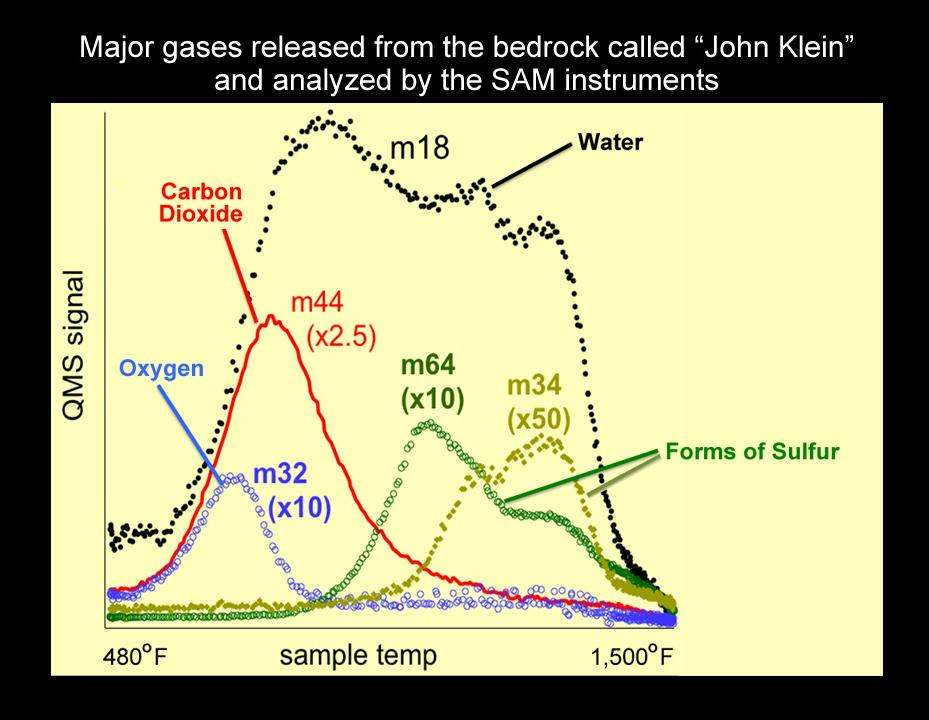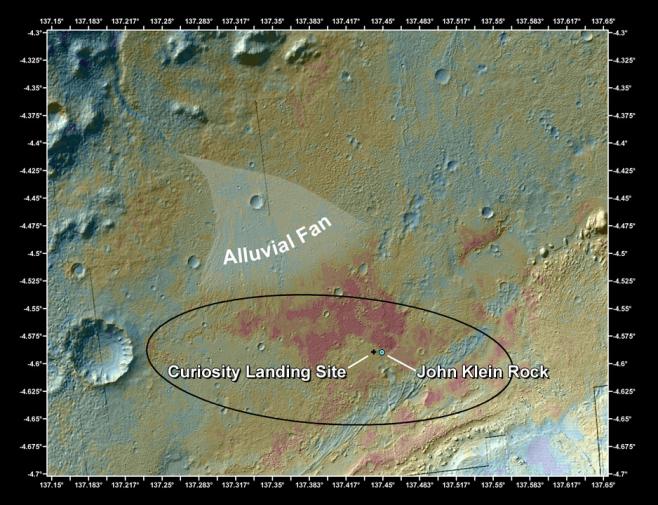Listing down the evidence from the most prominent one to the minor ones from different instruments aboard the rover:
- First from the Chemical and Mineralogical instrument; this instrument investigates concentrations of chemical compounds and minerals in the sample it receives. By the use of the X-ray diffraction instrument which I explained about here, we see a spectrum that is similar to the previous site of investigation called 'Rocknest' which contained plagioclase feldspar, olivine and pyroxene with small amounts of anhydrite, magnetite and about 25-35% of amorphous (non-crystalline) material. None of these minerals are asscoiated with hydrological activity. Roughly the same was found at John Klein except for a signal that proved to be the holy grail of the mission, atleast 20% phyllosilicates (which in this case; smectite). These are clay minerals whose presence cannot be explained without invoking lots of neutral pH water or normal water that you would drink without high acidity or alkalinity. Here my friends is the turning point in the mission. Although Gale was chosen for a landing site by having a lot of this stuff to study, Curiosity's discovery has forced the mission team to reshuffle their priorities by making the study of the area John Klein lies in (an alluvial fan) a primary objective instead of a secondary objective.
 |
| X-ray diffraction spectrum of Rocknest and John Klein comparison. The signal for clays is annotated. (NASA/JPL/Ames) |
2. To confirm CheMin's signal, we turn to SAM, the sample analysis at Mars instrument which also says the same. For a reminder of how SAM works go here. The evidence comes from the quadropole mass spectrometer which detects chemicals based on their mass and measures their abundances by signal intensity. The result was this graph that shows signal intensity against temperature at which the volatiles were released.
 |
| (NASA/JPL/GSFC) |
Diagnostic of clay is the presence of a high water release. So both of Curiosity's analytical instruments show evidence for this mineral class which is excellent. But apart from that we see certain interesting features in the data. We see sulphur containing minerals of 2 kinds; oxidised and reduced forms. These are probably sulphur dioxide and and hydrogen sulphide as far as the masses go. This is extremely interesting to the scientists:
Scientists were surprised to find a mixture of oxidized, less-oxidized, and even non-oxidized chemicals, providing an energy gradient of the sort many microbes on Earth exploit to live. This partial oxidation was first hinted at when the drill cuttings were revealed to be gray rather than red.
Usually organisms require reduced chemicals to oxidise and release energy here on Earth. So what we're seeing may constitute a potential energy source for a microbe finding itself on Mars."The range of chemical ingredients we have identified in the sample is impressive, and it suggests pairings such as sulfates and sulfides that indicate a possible chemical energy source for micro-organisms," said Paul Mahaffy, principal investigator of the SAM suite of instruments at NASA's Goddard Space Flight Center in Greenbelt, Md.
3. From SAM again we see from the tunable laser spectrometer a new deuterium to hydrogen ratio which is higher than what we have seen at Rocknest. At that location it was taken as evidence that Mars has lost a lot of its atmosphere since it was formed. A higher ratio means that John Klein is giving us a window further into the past (older rocks are supposed to contain more clays indicative of a wetter past 3 billion years ago) when Mars may have had a thicker atmosphere than what we have today. Again this is conducive for habitability.
4. The final line of evidence comes from comparing images of rocks seen by Curiosity with those taken of rocks by the Opportunity rover over at Meridiani planum where it too is investigating smectite rich rocks. The rocks are similar in appearance and both contain concretions it seems, indicating a history of water transport, cementation and alteration of the rocks. Beautiful!
 |
| The high thermal inertia area comprising Yellowknife bay is highlighted in red. (NASA/JPL/ASU) |
 |
| View of the inner solar system from above with the Celestia program illustrates the current beginnings of planetary comjunction of the Earth, sun and Mars. Direct comms will be interfered by the sun. |

No comments:
Post a Comment